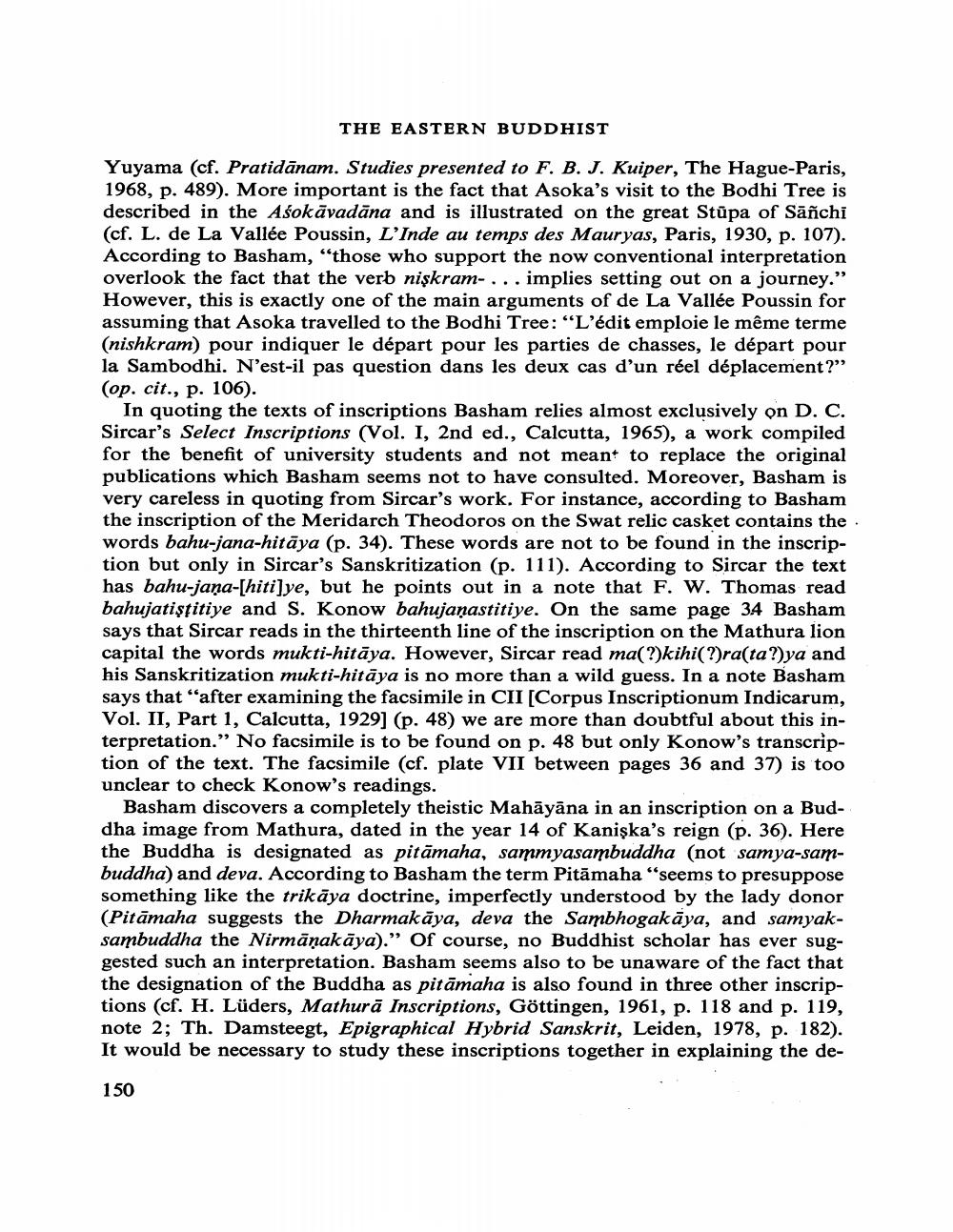________________
THE EASTERN BUDDHIST
Yuyama (cf. Pratidānam. Studies presented to F. B. J. Kuiper, The Hague-Paris, 1968, p. 489). More important is the fact that Asoka's visit to the Bodhi Tree is described in the Açokāvadāna and is illustrated on the great Stupa of Sāñchi (cf. L. de La Vallée Poussin, L'Inde au temps des Mauryas, Paris, 1930, p. 107). According to Basham, "those who support the now conventional interpretation overlook the fact that the verb niskram- ... implies setting out on a journey." However, this is exactly one of the main arguments of de La Vallée Poussin for assuming that Asoka travelled to the Bodhi Tree: “L'édit emploie le même terme (nishkram) pour indiquer le départ pour les parties de chasses, le départ pour la Sambodhi. N'est-il pas question dans les deux cas d'un réel déplacement?" (op. cit., p. 106).
In quoting the texts of inscriptions Basham relies almost exclusively on D. C. Sircar's Select Inscriptions (Vol. I, 2nd ed., Calcutta, 1965), a work compiled for the benefit of university students and not meant to replace the original publications which Basham seems not to have consulted. Moreover, Basham is very careless in quoting from Sircar's work. For instance, according to Basham the inscription of the Meridarch Theodoros on the Swat relic casket contains the words bahu-jana-hitāya (p. 34). These words are not to be found in the inscription but only in Sircar's Sanskritization (p. 111). According to Sircar the text has bahu-jana-[hiti]ye, but he points out in a note that F. W. Thomas read bahujatiştitiye and S. Konow bahujanastitiye. On the same page 34 Basham says that Sircar reads in the thirteenth line of the inscription on the Mathura lion capital the words mukti-hitāya. However, Sircar read ma(?)kihi(?)ra(ta?)ya and his Sanskritization mukti-hitāya is no more than a wild guess. In a note Basham says that "after examining the facsimile in CII (Corpus Inscriptionum Indicarum, Vol. II, Part 1, Calcutta, 1929] (p. 48) we are more than doubtful about this interpretation." No facsimile is to be found on p. 48 but only Konow's transcription of the text. The facsimile (cf. plate VII between pages 36 and 37) is too unclear to check Konow's readings.
Basham discovers a completely theistic Mahāyāna in an inscription on a Buddha image from Mathura, dated in the year 14 of Kaniska's reign (p. 36). Here the Buddha is designated as pitämaha, sammyasambuddha (not samya-sambuddha) and deva. According to Basham the term Pitāmaha "seems to presuppose something like the trikāya doctrine, imperfectly understood by the lady donor (Pitāmaha suggests the Dharmakāya, deva the Sambhogakāya, and samyaksambuddha the Nirmāņakāya).” Of course, no Buddhist scholar has ever suggested such an interpretation. Basham seems also to be unaware of the fact that the designation of the Buddha as pitämaha is also found in three other inscriptions (cf. H. Lüders, Mathurā Inscriptions, Göttingen, 1961, p. 118 and p. 119, note 2; Th. Damsteegt, Epigraphical Hybrid Sanskrit, Leiden, 1978, p. 182). It would be necessary to study these inscriptions together in explaining the de
150




